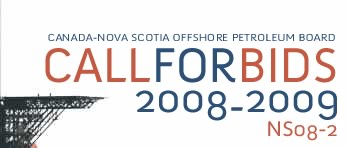
Exploration History
Land Parcel #1
The center of Parcel 1 is located about 180 km southwest of the western side of Sable Island, in water depths ranging from 1100 to 3600 m. It is bounded on its western side by Parcel 2 of the NS08-1 Call for Bids, an industry nominated block that received a successful bid of $129,000,000, in November, 2008 (Exploration Licence 2419 will be issued for this land on January 1, 2009). The northern and southern sides of the block are flanked by open crown land, and the eastern side is bounded by ![]() Parcel 2 of the NS08-2 Call for Bids. There are no significant discovery licences in this part of the Scotian Basin.
Parcel 2 of the NS08-2 Call for Bids. There are no significant discovery licences in this part of the Scotian Basin.
Only one well, Shubenacadie H-100, was drilled on Parcel 1, but it did not test strata deeper than the Upper Cretaceous. It was spudded by Shell in 1982 and was Nova Scotia's first deepwater well. The primary target was an interpreted lower Tertiary turbidite fan, and the secondary target was a Miocene "bright spot" believed to be a direct hydrocarbon indicator. The well did not encounter any hydrocarbons and the primary target was later determined to be an erosional remnant. Four other wells were drilled in relatively close proximity to Parcel 1: Acadia K-62, Newburn H-23, Weymouth A-45, and Evangeline H-98 (details on these wells are presented in the table below).
| Well | Year Spudded |
Water Depth (m) |
Total Depth (m) |
Target Fm. Age |
Play / Trap |
| Acadia K-621 | 1978 | 866 | 5267 | Iroquois Early Jurassic |
Reef margin structural high |
| Newburn H-234 | 2002 | 977 | 5983 | Lower Missisauga Early Cretaceous |
Turbidite fan in a detachment fold |
| Evangeline H-983 | 1984 | 174 | 5044 | Logan Canyon/Upper Missisauga Cretaceous |
Shelf sands in rollover anticline |
| Shubenacadie H-1002 | 1982 | 1476 | 4200 | Banquereau Early Tertiary |
Turbidite fan |
| Weymouth A-455 | 2003 | 1690 | 6520 | Mid/Lower. Missisauga Early Cretaceous |
Turbidite fan in a subsalt anticline |
NOTE: Comprehensive reviews of the listed wells can be found in the following sources:
1 Acadia K-62: The Upper Jurassic Abenaki Formation Offshore Nova Scotia: A Seismic and Geologic Perspective (CNSOPB, June 2005, p.117–134).
2 Shubenacadie H-100: Nova Scotia Deepwater Post-Drill Analysis 1982–2004 (CNSOPB, October 2007, p.54–61).
3 Evangeline H-98: Nova Scotia Deepwater Post-Drill Analysis 1982–2004 (CNSOPB, October 2007, p.62–68).
4 Newburn H-23: Nova Scotia Deepwater Post-Drill Analysis 1982–2004 (CNSOPB, October 2007, p.96-106).
5 Weymouth A-45: Nova Scotia Deepwater Post-Drill Analysis 1982–2004 (CNSOPB, October 2007, p.123-132).
Acadia K-62 is located northwest of Parcel 1; it targeted the Jurassic carbonate bank and therefore does not contribute to the understanding of the deepwater systems in this area. Of the remaining wells, the most relevant to Parcel 1 is Newburn H-23 which was spudded by Chevron et al in 2002 and targeted a detachment fold containing seismically defined Lower Cretaceous deepwater turbidite sandstone reservoirs. The well encountered three relatively thin (< 6 m) gas charged turbidite sandstone intervals, and one >15 m thick turbidite sandstone/ conglomerate interval with no pay. Newburn H-23 established that an active hydrocarbon system is present in the deepwater portion of the southwestern Sable Subbasin, and the presence of coarser clastics indicates that there were periodic influxes of vigorous sediment gravity flows into deepwater during the Early Cretaceous (Chevron et al., 2002). No significant hydrocarbon bearing intervals were found in any of the other wells.
Portions of Parcel 1 were also explored by Shell Canada Limited and its partners ExxonMobil, Esso and Chevron, who picked up EL 2381 and EL 2382 in July of 1999. They also acquired a large 3D seismic volume (4530 km2) in the summer of 2000 (Western Geophysical; Program #NS24-S06-01E) and 2001 (WesternGeco) (Program #NS24-S06-02E), which covers about half of Parcel 1. The lack of thick reservoir in the nearby Newburn H-23 well, combined with the industry's lack of success in adequately predicting reservoir presence in other deepwater wells, were probably contributing factors that led Shell and its partners to forfeit EL 2381 and EL 2382 in June of 2004.
A number of seismic surveys have been acquired over portions of Parcel 1 since the early 1970s. Interpretation reports are available for many of them, with the following table listing the available programs.
| Seismic Program # (links by program) |
Operator (links by company) |
Year |
| Confidential Programs | ||
| 2003 | ||
| 2003 | ||
| 2003 | ||
| 2000 | ||
| 1999 | ||
| 1998 | ||
| 1998 | ||
| Off-Confidential Programs | ||
| 2001 | ||
| 2001 | ||
| 1988 | ||
| 1985 | ||
| 1983 | ||
| 1983 | ||
| 1983 | ||
| 1982 | ||
| 1982 | ||
| 1981 | ||
| 1981 | ||
| 1980 | ||
| 1979 | ||
| 1978 | ||
| 1973 | ||
| 1973 | ||
| 1972 | ||
| 1972 | ||
| 1971 | ||
| 1970 | ||


